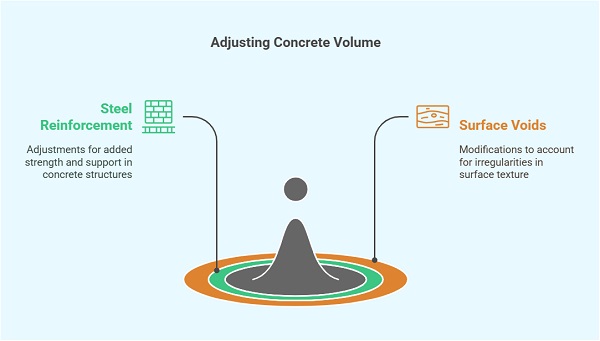Concrete Volume Calculator (Imperial)
© Imperial Calculator Ltd 2025. Disclaimer: All Converters in the Imperial Calculator have been reviewed by the relevant Imperial measurement system experts.
The Formula for the Concrete Volume Calculator in Imperial
Formula:
Concrete Volume = Length × Width × Depth (in feet)
Where:
- Length is the length of the concrete area in feet.
- Width is the width of the concrete area in feet.
- Depth is the depth of the concrete in inches, but it is first converted to feet (since 1 foot = 12 inches).
So the final formula becomes:
Concrete Volume (cubic feet)=Length × Width × (Depth (in inches) ÷ 12)
Table of Contents
Why Use a Concrete Volume Calculator?
When pouring concrete, knowing the exact volume is essential. Whether you’re working on a slab, footing, column, or wall, an accurate calculation prevents material waste and ensures a smooth construction process.
A concrete volume calculator helps determine how much concrete you need before mixing or ordering materials. This saves time, reduces costs, and avoids shortages or excess waste. It also ensures consistency in construction projects.
Concrete Volume Formula (Imperial)
The formula for calculating concrete volume depends on the shape of the structure. The most common shapes include slabs, footings, columns, and walls.

Volume Formula for a Slab (Rectangular)
Volume=Length×Width×Thickness
Example:
- Length = 10 feet
- Width = 5 feet
- Thickness = 0.5 feet (6 inches)
Volume=10×5×0.5=25 cubic feet
Convert cubic feet to cubic yards:
Cubic Feet ÷ 27=25 ÷ 27=0.93 cubic yards
Volume Formula for a Column (Cylindrical)
Volume= π × Radius² × Height
Example:
- Radius = 1 foot
- Height = 6 feet
Volume=3.1416×(1²) × 6 =18.85 cubic feet
Convert to cubic yards:
18.85 ÷ 27 = 0.70 cubic yards
Volume Formula for a Wall
Volume=Length×Height×Thickness
Example:
- Length = 12 feet
- Height = 8 feet
- Thickness = 0.5 feet
Volume=12×8×0.5=48 cubic feet
Convert to cubic yards:
48÷27=1.78 cubic yards
Factors That Affect Concrete Volume
Shrinkage and Waste Allowance
Concrete shrinks slightly as it cures. Adding 5-10% extra ensures enough material.
Reinforcement and Voids
Steel reinforcement and voids in rough surfaces may require slight adjustments in volume.
Mixing and Slump
A higher water-to-cement ratio affects workability but does not change the solid volume.
Common Conversions for Concrete Volume
| Unit | Conversion |
| 1 cubic yard | 27 cubic feet |
| 1 cubic foot | 7.48 gallons |
| 1 cubic yard | 201.97 gallons |
| 1 bag (94 lbs) | 1 cubic foot (approx.) |
Step-by-Step Guide to Using a Concrete Volume Calculator
- Select the shape – Choose between slab, footing, column, or wall.
- Enter dimensions – Input length, width, and thickness for slabs; radius and height for cylinders.
- Calculate volume – Use the correct formula for each shape.
- Convert units – Convert cubic feet to cubic yards if needed.
- Adjust for waste – Add 5-10% extra concrete to account for shrinkage and spillage.
How Much Concrete Do You Need?
Ordering Ready-Mix Concrete
Concrete suppliers sell by the cubic yard. Use a calculator to determine the total required amount and round up slightly for safety.
Mixing Your Own Concrete
If mixing manually, calculate the total volume and use appropriate proportions of cement, sand, and gravel.
Frequently Asked Questions (FAQ)
How do I calculate concrete volume in cubic yards?
Divide the volume in cubic feet by 27 to get cubic yards.
Should I order extra concrete?
Yes, adding 5-10% extra helps account for waste and shrinkage.
How many bags of concrete are needed per cubic yard?
One cubic yard requires about 45 bags (each 80 lbs) of pre-mixed concrete.
